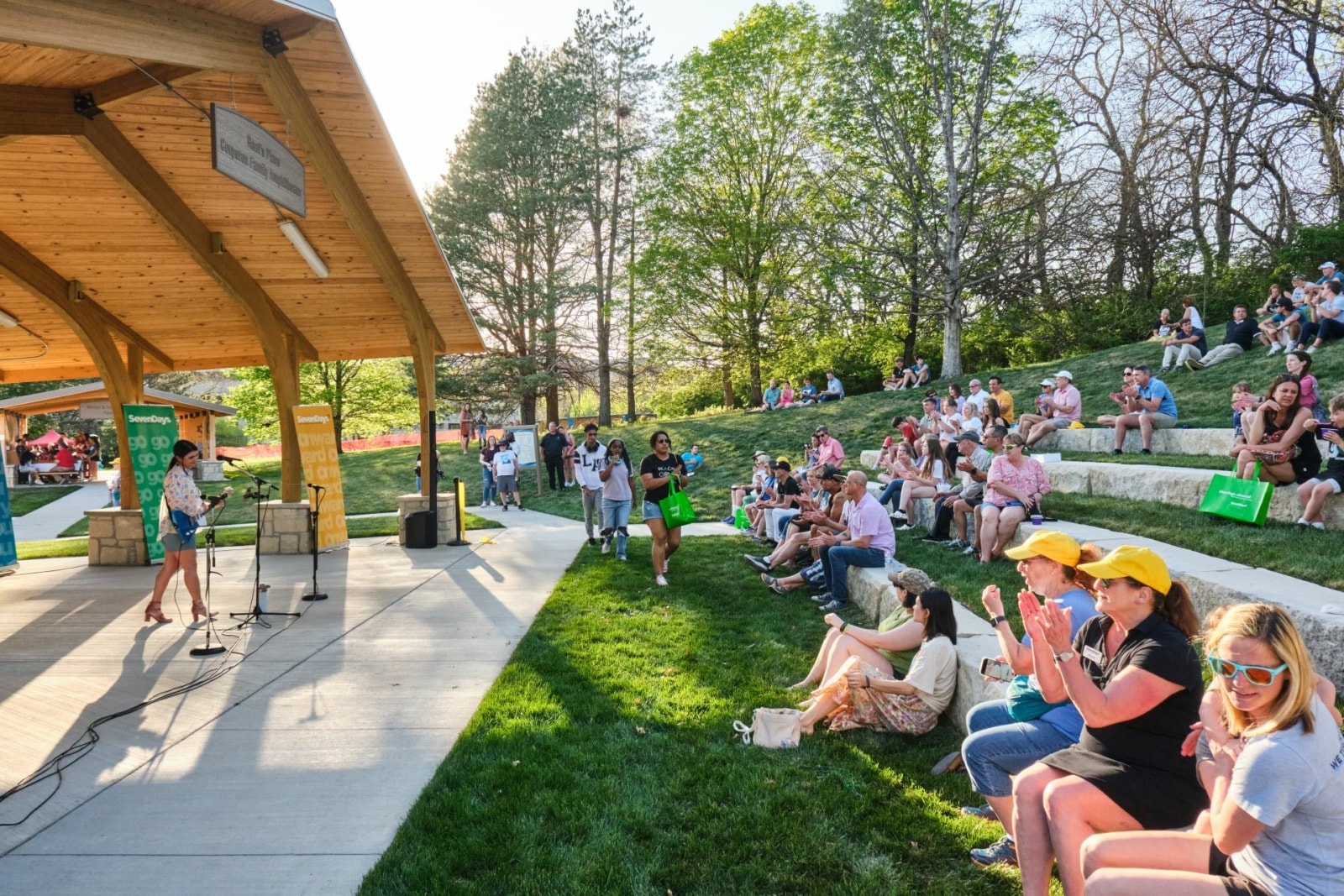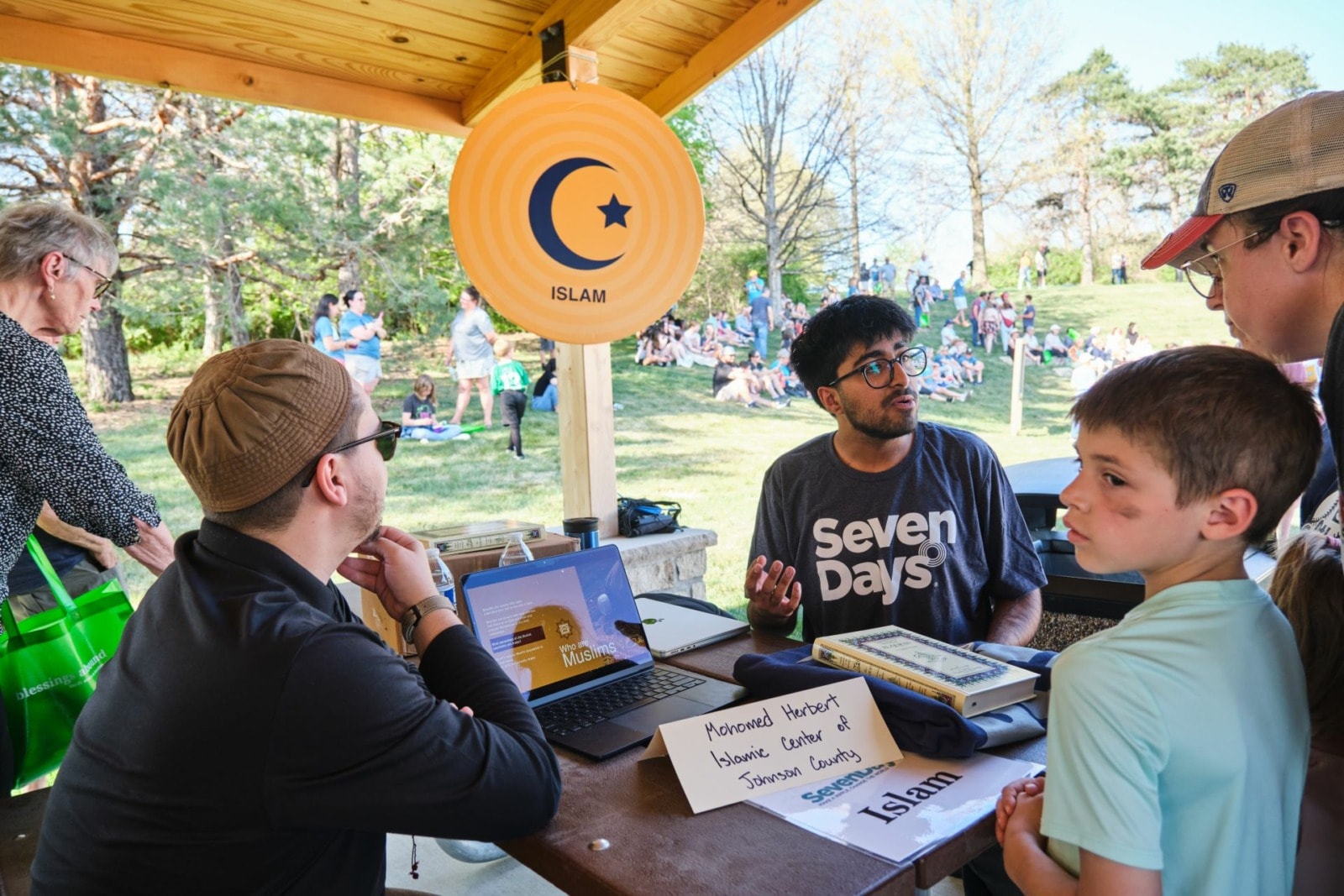Healing Hate: How to Build a More Resilient Kansas City A Decade After an Antisemitic Hate Crime, Communities Embrace the Science Behind Helping Children Recover
Published April 18th, 2024 at 6:00 AM
Above image credit: Berkley Selvin was among a group of teenagers locked into a room shortly after the shooting in April of 2014, a hate crime that took the lives of three area residents. (Cody Boston | Flatland)As a 15-year-old, Berkley Selvin was a prime target of an antisemite’s murderous rampage at the Jewish Community Center campus in Overland Park.
She survived.
Not only that day, but through what could have become debilitating survivor’s guilt that surfaced years later.
How she did so, even finding a sense of purpose that shapes her career choices today, tracks with what science has learned about experiencing trauma and building resilience.
Especially when it affects children.
“The human story is never boring,” said Dr. Denise Dowd, with Children’s Mercy Hospital. “It’s a story of resilience. “It’s a story of strength. It’s a story of overcoming.”
Dowd is part of an expert team formed through the American Academy of Pediatrics that is developing a national Center for Trauma Informed Pediatrics.
The effort, funded by the Centers for Disease Control and Prevention (CDC), is a gamechanger that’s been a long time coming, Dowd said.
As a result, barriers that have long existed between differing fields of science are falling.
The Science of Trauma
How trauma affects people biologically, the science of the brain and related mental health disciplines are involved, along with educators.
Dowd, who has 30 years of experience as a nurse, an emergency room physician and as a professor, is hopeful.
The work is a response to the daunting, societal challenges that trouble many Americans. Shootings in and around schools. Domestic violence. Addictions. Violent crime. Homelessness. Untreated mental illness. And the toxic stress of intergenerational poverty.
“There’s this convergence of all these disciplines and you can feel it,” Dowd said.
Eventually, the effort could influence public policy, becoming part of the line of work that Selvin has chosen.
She’s 25 now. After graduating from college, she decided to work in politics partly due to her experiences — not as a candidate, but as an integral staffer.
“I wanted to work with people who understand the profound impact that violence has on a community,” she said.
Kansas City media has been consumed in recent days with recounting the terrifying day that happened when Selvin was a child.
Three people were killed at the Jewish Community Center campus in Overland Park and at nearby Village Shalom, a nursing center.
Honoring the lives of 14-year-old Reat Underwood, his grandfather Dr. William Corporon and wife and mother Terri LaManno is tremendously important, for both community and individual healing.
Each left an impactful legacy.
Several factors intervened in Selvin’s favor on April 13, 2014, when a now-deceased gunman tried to shoot his way into the Jewish Community Center, intent on murdering Jewish people.
The door to the downstairs meeting room where she and a group of girlfriends had planned to gather was locked. The group, the leadership board with the B’nai B’rith Youth Organization Inc., ran upstairs to an available room.
They had shifted their meeting 15 minutes, arriving early, because they had a full agenda.
Each factor helped keep the girls out of harm’s way.
But Selvin also had other elements that studies have found helpful in building personal resilience — faith, identity and caring adults.
Flatland in Focus
In fact, research shows that one stable adult in a young person’s life can have a dramatic impact in helping children cope, even in the face of great challenges.
“There was a long period of time where I really couldn’t articulate what I was feeling,” Selvin said.
Of the three people who died the day of an antisemitic hate crime, none were Jewish.
About five years passed before Selvin’s survivor’s guilt fully surfaced, compounded by violent antisemitic attacks and mass shootings that occurred in other cities during her college years.
For Selvin, the encouragement of Reat’s mother, Mindy Corporon, was crucial.
The two didn’t know each other until years after the shooting.
Finally, Selvin wrote Corporon a letter, pouring out what had happened that day, how the girls had been locked down, exiting only when police slid their badges under the door.
The teens saw the chaos of the crime scene in the parking lot where Reat and his grandfather had been shot.
When Selvin finally met Corporon over coffee, she recounted all of it.
Corporon held Selvin’s hands, looked her in the eye and assured the young woman that she’d survived for a reason.
“It was very tearful and very painful for her,” Corporon said of their first meeting. “I just said, ‘You know, I’m not angry at you for living and Reat would want you to live.’ I think she needed to hear that from me. She just felt so guilty for living.”
The assurance, delivered with kindness and empathy, is what Selvin needed.
“It was unbelievably healing, Selvin said. “I can’t even put into words how healing that was for me, after all those years.”
The two women continue to be supportive of each other, checking in when news breaks that might stir emotions from that April day.
“She tells me, that ‘You’re supposed to be here, and you survived for a reason,’” Selvin said. “I needed to hear that.”
Resilience as ‘Ordinary Magic’
America is deep in discussions about trauma and mental health.
Trigger warnings are placed on movies. Public service announcements promote suicide hotlines. And medications to address depression are common.
And yet, we tend to get basic facts about trauma wrong.
The word, Dowd said, is used so often that too many incidents are looped in.
“By trauma, we mean it’s an event or a series of events that are physically or emotionally harmful, that can have lasting effects,” Dowd said. “But there has to be a perceived or real threat to life and limb.”
She, like other experts, said it is positive that young people are willing to speak about their mental health, how they are feeling or coping with aspects of their lives.
Each day in the metropolitan area, and likely every single minute, someone faces adversity.
Community-wide, the most recent example is the shooting after the recent Super Bowl victory parade, where Lisa Lopez-Galvan died, multiple people were shot but lived, and much of the city came away terrorized with a heightened fear of random gunfire.
Gunfire that is far more common in lower income areas, especially Kansas City’s East Side where many African American families live, can overwhelm people’s sense of control.
But too often, people persevering against adversity are celebrated without examining how they bounce back, even from terrifying events like a hate crime.
Their ability to cope is often labeled as an extraordinary, nearly inhuman trait.
The opposite is true.
Resilience has been described by a leading researcher as “ordinary magic.”
Ann S. Masten wrote a book from her findings, “Ordinary Magic, Resilience in Development.”
From a summary of her findings: “The study of resilience in development has overturned many negative assumptions … about children growing up under the threat of disadvantage and adversity. The most surprising conclusion emerging from studies of these children is the ordinariness of resilience.”
Identity, faith and the impact of even one stable adult in a young person’s life have been found to be important factors in helping children cope, recover and build resilience.
And certainly, the help and counseling of trained therapists can be important.
In many ways, the nonprofit work of Corporon underscores the research.
Her first endeavor was called the Faith Always Wins Foundation, a nod to how a belief in God, an afterlife and spiritual teachings have been a part of her healing, and that of others.
“I immediately knew that my son and father were in heaven,” she said of those first few moments when she arrived at the Jewish Community Center campus.
The nonprofit is now called SevenDays and it emphasizes spreading kindness, especially among youth.
The coping that can occur by showing empathy and kindness to others has also been documented in research.
For Corporon, it’s a relatively simple formula.
“When my heart hurts, I know I need to give more,” she said.

Other researchers have framed findings as the human tendency toward “antifragile.”
The research shows that humans are adaptive beings, hardwired to overcome.
“Our tendency is as a biological creature who adapts, and in response to stress, the real potential is to actually get stronger,” Dowd said.
It’s much like when a person lifts weights, the resistance to the weight builds the muscle’s strength.
Dowd said adages like “whatever doesn’t kill me, will make me stronger” would be an oversimplification.
But the studies should flip some common assumptions.
There is a penchant to label people negatively who have undergone a trauma or who were born into harsh circumstances, such as chronic poverty or high-crime neighborhoods.
Dowd emphasizes the importance of leaning into people’s inherent strengths, what makes them unique, rather than treating someone who has experienced trauma as if the experience makes them lesser.
Their strengths can help cultivate resilience.
“When people focus too much on what is wrong, the brokenness, it’s necessary to reframe trauma,” she said. “To say, ‘Look, this is what happened to you. It’s not your destiny.’”
Adversity is Common
Kansas City did its own research.
The Greater Kansas City Chamber of Commerce helped lead an initiative called Resilient KC: Thriving Through Adversity in 2016.
The project drew from a wide range of partners, including Children’s Mercy Hospital, Blue Cross and Blue Shield of Kansas City and more than 100 health organizations, advocacy groups, hospitals, businesses and foundations.
Much of the effort stemmed from asking people to answer a set of questions, based on research from 1995-1997.
By tallying Adverse Childhood Experiences, or ACEs, early researchers found strong statistical correlations between the number of adversities faced in childhood and negative outcomes for health when that child became an adult.
The original study by the CDC and Kaiser Permanente is considered groundbreaking.
As a research tool, the findings were the first to correlate traumatic incidents and circumstances in childhood – such as witnessing domestic violence, having a parent incarcerated or living with an adult with substance abuse or a mental illness – with behaviors later that put their health at risk, and the presence of heart conditions, cancer and other diseases.

Locally, 3,499 people took the ACEs survey in the nine-county, bi-state area.
Among the findings: Nearly five in 10 Kansas City area adults reported that they’d witnessed a parent or adults in their home being physically or emotionally battered, which was four times the rate found in the original survey.
The Kansas City study also expanded the categories, asking questions about witnessing violence in their neighborhood as children, feeling discrimination based on race/ethnicity, being bullied or living in foster care.
According to the CDC, about 64% of U.S. adults report they’ve experienced at least one type of adverse childhood experience before the age of 18. And nearly 1 in 6 (17%) report four or more such experiences.
But at least one asterisk is necessary.
The original ACEs questions were never intended to be a scoring system for an individual, or to be used as a screening tool.
How a score – such as an exposure to three adverse conditions in childhood – might play out for an individual is vastly different than across populations of people, like a racial or geographical group.
Further, the original study was done with middle class, insured people.
What’s more universal are the factors that help build resilience.
Building Resilience
Rachel Trout was with Selvin that day in April 2014.
She helped barricade the door and called family members. Her brother, who was away at college, insisted that he could drive the Jewish Community Center campus.
“I remember … realizing that this happened because he wanted people like me dead,” she said of the shooter.
She took off her necklace, a silver Star of David that she’d worn daily since being given it for her bat mitzvah.
“It wasn’t shocking to me that people hated Jews, like I knew that,” Trout said. “But I was scared to be Jewish for a while after.”
Her mother intervened, talking with her daughter, telling her that it was OK to be scared, but also counseling that it needn’t dampen her pride in being Jewish.
In the days that followed, Trout helped organize a walk with fellow students to honor Reat, who was a freshman at Blue Valley High School, where she was a sophomore.
She speaks of her “communities,” her mother and other people she was close with — her Jewish circles.
All can be resilience building, especially the insulating power of a keen sense of identity. Faith has also been shown in research to help.
“It was like a transition,” Trout said. “A decision to be unapologetically Jewish. I put my necklace back on. This is who I am.”
Healing Hate
The support that Trout experienced is referred to as safe, stable, nurturing relationships (SSNR), even if it is just one stable adult in an otherwise chaotic or stressful childhood.
The Blue Valley School District continues to improve how it addresses the challenges that children face.
The challenges are clear. One in five teens live with a mental health condition. Half of those dealing with a mental health condition are doing so by the age of 14. And three-quarters of them will develop a condition by the age of 24.
In the 2022-23 school year, the district began Mental Health First Aid, first training the educators who spend the most time with students, like coaches and the sponsors.
The training helps them recognize the signs and symptoms of a mental health challenge or crisis a youth is experiencing. The children can then be referred for help.
Reat’s former debate teacher is among more than 500 educators in Blue Valley who have completed it.
“We’re equipping them with the knowledge and the strategies and just the confidence that they need to approach our young people and ask them the hard courageous questions that ultimately lead them to getting the support, resources and care that they need,” said Kelly Wessel, director of human resources – retention and recruitment.
Conditions can include anxiety, depression, suicidal ideation, impulse control disorders, or just a stressful time with factors outside of a student’s control, like a divorce.
Staff are being given science-based information, a heightened awareness to differentiate between what is normal adolescent behavior and what might be signs of a teenager needing some help.
Trout remembers school staff doing outreach among students at the time of Reat’s death, but said that for her, a strong sense of community and support was found outside of the district.
Trout is in medical school now.
When she wrote her entrance essay, she reflected on surviving the shooting and her feelings immediately after, grappling with the hatred that drove the killings, fears it ignited and a sense that for some people, Jews don’t count as human.
“I wrote my whole personal statement about how I want to be a doctor who makes sure that no one ever feels that way in their health care,” she said. “It’s played a huge role in who I am today.”
Mary Sanchez is senior reporter for Kansas City PBS. Cody Boston is a multimedia producer for Kansas City PBS and the producer of “Flatland in Focus.”




